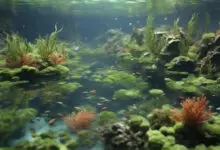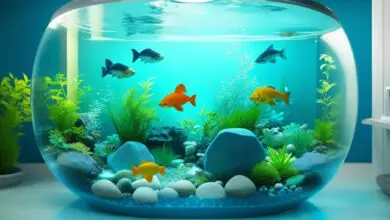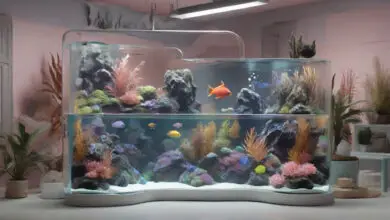Keeping Aquarium Fish Happy and Healthy

Fish can easily get stressed in tanks. Stress makes them sick and kills them faster. It comes from bad water, bullying tankmates, or too much noise. There are many stress causes to watch for. Catching issues early keeps fish healthy. Fixing tank problems prevents future stress. Knowing fish behavior also spots stressed fish before they get too ill. Stopping stress improves fish lives in small tanks.
What is Fish Stress?
Stress is the body’s response to threats or change. For fish it means something is wrong in their tank. The stress response lasts a short time like handling fish for cleaning. Or it can continue for a long time if tank issues are not fixed, like bad water. Long-term stress is very bad for fish.
Fish release stress hormones like cortisol when scared or upset. Too many hormones make them weak to disease. Functions like breathing and digestion get disrupted. Fish struggle fighting illnesses and stop eating until they die. Tanks changes meant to help can also be stressful events. So owners must upgrade gently.
Frequent mild stress is tolerable and fish recover after. But severe or prolonged issues overload fish beyond their limits. Knowing all causes of stress helps prevent fish from crossing over into the danger zone past what they can handle.
Signs of Stressed Out Fish
Fish act differently when feeling stressed. Recognizing symptoms early leads to quicker diagnosis and relief for them. Common signs of stress include:
- Hiding all the time
- Losing coloring
- Not eating
- Heavy breathing
- Jumping from water
- Twitching or erratic swimming
Fish float along normally when content. But stress behaviors warn of water quality or harassment issues. Missing signs means losing inhabitants getting sicker secretly. Careful checks twice per day give fish the quickest help. Prevention also limits stress by fixing triggers identified easily.
Common Causes of Aquarium Fish Stress
Tanks aim to mimic safe natural environments. But many common mistakes actually distress captives badly. Avoiding these critical pitfalls vastly improves relaxation and longevity fish experience:
1. Poor Water Quality
Dirty water spikes toxins like ammonia that directly burns fish gills and tissue. And rapid chemistry shifts stir anxiety. Keeping balances stable avoids environmental stress letting immune health persist.
2. Aggressive Tankmates
Bullying tankmates inflict physical harm and constant fear. Weaker fish never relieve tension. Separating aggressors into isolation or paired species tanks grants original stocks renewed calm.
3. Improper Handling
Physical handling should minimize anytime possible. But moves and treatment require occasional disturbance. Using correct nets without rough fabric lowers stress responses further. And never exposing fish to open air prevents organ damage from suffocation possibilities. Support bodies fully when out of water.
4. Loud Environments
Fish sense sound vibrations far louder than comfortable submarine life. Positioning tanks away from frequent household noises gives inhabitants steady peace. Turn off pH controllers and cover tops to limit disruptions where able too.
5. Small Living Spaces
While newcomers assume large showy tanks suit fish best, open barren environments actually spike stress hormones from lack of hideouts. Plenty of plant cover and decor replicating natural features offers privacy to retreat and regroup. Adding more gallons also divides aggressive interactions further.
Carefully avoiding factors fish view as threats keeps cortisol levels in check. Peak health results from upholding ideal water parameters plus designing proper aquascapes supporting species primitive needs continually.
Emergency Fish Stress Relief
Even perfect tanks sometimes need interventions against developing issues. Recognizing early stress behaviors gives chances to use emergency relief methods before complete shutdowns. Rapid remedies pull inhabitants back from the brink if caught soon enough.
Small Daily Feedings
Offer very small but frequent meals until appetites recover. Weak fish often lack strength swimming far for large pellets but accept tiny bits. Stimulating digestion this way helps recovery until normal diets return.
Salt and Stress Coat Additives
Products like API Stress Coat or aquarium salt safely comfort irritated slime coatings and gill tissues. Follow product labels using when replacing water after high ammonia readings. Slime coats supplement outside layers protecting raw flesh weakened by exposure.
Tank Blackouts
Plunging stressed tanks into 72 hours darkness lets inhabitants rest deeply. Light absence removes pressures forcing normal active cycles they lack energy for. Blackouts serve like sick day healing isolation. Extend blackouts until fish resume normal feeding before reintroducing light.
Emergency relief measures buy time until solving larger quality issues. isolate sick fish whenever possible too. While stress always requires attention, fast help pulls inhabitants back from brink once owners pinpoint original causes. Tank vigilance prevents smaller issues compounding before detection.
Long Term Stress Prevention in Aquariums
Preventing stress means recreating stable habitats aquarium fish evolved within. Thriving past bare survival requires keeping environments closely matching natural comfort levels fish need.
Match Tankmates by Lifestyle
Avoid mixing slow and fast moving fish with different feeding behaviors. Less aggressive species face eradication attempting to compete. Choose tankmates wanting the same water temps and pH instead for community success.
Upgrade Tank Sizes
Increasing gallons provides cleaner water and room escaping bullying. Tiny desktop kits require twice weekly maintenance missing danger signs between. Hobbyist level 50-75 gallon tanks maintain stability longer before topping off. Match occupants growth potential at purchase for long-term comfort.
Quarantine Newcomers
Isolation tanks allow gradual mergers once establishing pecking orders out of sight. Observe new fish appetites and behavior alone before risking community introductions. Daily water testing also protects ecosystems already balanced from outside sickness carried. Quarantines protect all tank investments.
Careful tankmate choosing prevents aggression issues. Bigger stabilizing systems rely less on urgent water changes. And separate acclimation tanks spotlight potential newcomer problems before endangering original inhabitants once joined together. Layered proactive plans keep stimulation within healthy limits fish naturally expect in captivity.
Recognizing Distressed Fish Early On
Even seasoned owners encounter puzzling sick cases. External parasite infections get diagnosed easily after recognition. And physical wounds require obvious bandaging responses. But internal stress related deterioration shows few warning signs until near terminal.
Catching stress requires close observation skills and specialty testing once issues surface. Pay attention for any behavior shifts after major tank changes. And consider proactive immunities boosting feeds before rather than after diseases emerge. Enable inhabitants to outlast rollercoaster environments thrown their way.
Behavior Differences
Comparing individual fish mannerisms week over week best detects stress. Take notes on activity levels and feeding schedules for each fish routinely. Track things like favorite tank zones or displays of dominance. Any deterioration catching up then alerts intervention needs before visible markings appear externally. Careful logs help baseline unusual changes.
Skin and Eye Exams
Inspect fish skin and eyes twice per week minimum hunting down signs of parasitic infections or fungus spread. Use quarantine boxes and magnifying glasses under bright light. Catch worsening red streaks, flashing against objects, or bloody wounds fast. Treat based on broad symptom families before identifying exact disease types.
Respiration Rate Tracking
Count regular gill movement rates per minute when fish float calmly. Higher rates reveal declining function from toxicity creeping internally. Compare species charts to know what is normal under ideal conditions. Consider supplemental oxygen if entire tanks breathe heavier without reason.
When issues emerge, take time studying individuals to gauge stability challenges. Prevent future stress events determining what tipped the balance over first. Always upgrade environments incrementally once realizing current capacity. Every improvement pushes ecosystems farther from teetering thresholds endangering those relying on captive care for lifetime health.
Diagnosing Stress Factors
Pinpointing the exact stress triggers helps guide suitable fixes. But primitive species lack verbal capacity reporting issues. So owners detective multiple clues slowly ruling out suspects changing comfort.
Record All Tank Events
Log everything added or adjusted near windows of declining health. Medications, new tankmates, and food introduction timings reveal what tweaks potentially enabled stress. Review anything altered in the surrounding tank environment too, even decor moved nearby. Changes stir anxiety unless very gradual.
Cross Examine Equipment
Inspect gear for developing flaws dropping life support quality. Review filtration cleaning logs to identify if rising nitrates link timing together. Monitor pumps powering flow for silt buildup slowing turnover. And calibrate test kits ruling out false positive spikes reported. Deductive trials uncover hardware faults before total system crashes.
consider All Seasons Of Life
Fish naturally fade into old age or changing life stage requirements also taxing acclimation abilities. Breeding seasons prompt territorial aggression invading former community ease. And elderly systems fail adapting once vibrant parameters degrading very slowly around them over many years. What worked well before now sinks spirits from within.
Rational problem solving must rule out all variables systematically to uncover sudden or creeping drops in captive health. If no changes made issues worse, improving fundamental size constraints and enrichment accommodations simply comforts inhabitants better long term. They deserve living rewards beyond just solving illnesses as they repeatedly appear.
Lifelong Stress Buffering Strategies
Preparation paves smooth roads holding course when equipment falters or disease attacks. Building layered defenses reinforces tanks tolerating heavier hits. Creating stability upfront prevents mass losses down road.
Hospital Tank Designs
Dedicate permanent quarantine space alongside main systems using individual sponge filters. Keeping meds and water changing gear handy allows quick isolation and treatment setup without scramble. Prepare hospitals for necessary persona care during community exile.
Breeding Backup Species
Successful spawns generated from stable conditions produce genetic lines more adapted to aquarium settings. Isolate immune bloodlines better withstanding environmental variances passing generations forward. Custom life ensures higher post-crisis survival rates.
Nature Inspired Modeling
Natural spaces thrive because whole communities evolved together over eons before capture. Recreate mini ecosystems intentionally planted balancing chemical export and oxygenation abilities long term. Test additives on plant-only setups first before dosing display attempts. Introduce inhabitants after gardens engineered to support far heavier waste burdens thrive on their own. Thorough small scale trials prove wider concepts keeping fragility low when conditions shift day to day inevitably.
Building resistance protects fish outside immediate control factors. Sample native source water for matching. Discover new backup keepers acclimating easily as mainstays fade away. And design fully independent nature systems first before adding fish as last parameter to balance thriving energy networks further.







